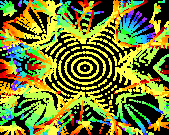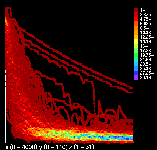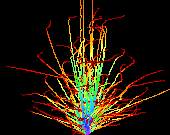This page is outdated. Refer to research group page instead!
![]() MD simulations of 10 - 200 keV collision cascade development
MD simulations of 10 - 200 keV collision cascade development
![]() Information on status of ion range calculations (TRIM, MDRANGE and all that)
Information on status of ion range calculations (TRIM, MDRANGE and all that)
The main research interests at our laboratory are using ion beam techniques to analyze and modify the properties of semiconductors and metals. Some nuclear physics of light elements is also done using our K=10 MeV tandem Van de Graff accelerator.
I myself have mainly developed and used computational methods to examine high-energetic processes in solids, chiefly semiconductors and metals, in close collaboration with experiments. The results of the simulations are used to further the fundamental understanding of radiation processes and as a sophisticated means of analysing experimental measurement results.

|
MD-GRID analysis of nuclear lifetimes
(1991-1994)
When a sample is irradiated with thermal neutrons,
some nuclei capture a neutron, go into an exited state
and decay from this state by emitting gamma-ray cascades.
When a nucleus emits a gamma quantum it gets kicked out
of its lattice position.
In the MD-GRID method the slowing-down process
of several thousands of exited nuclei is simulated using
molecular dynamics methods. In the adjacent figure 200
decays of 36Cl in NaCl is shown.
|
|||

|
From the simulations a two-dimensional velocity distribution
(like the one in the adjacent figure) is obtained. From
this distribution one can predict how the gamma spectrum
peak for a decay is Doppler broadened for different lifetimes.
By comparing measured peak line forms to the theoretical ones
the lifetime of the exited state can be calculated.
|
|||

|
MD simulations of high-energy (1-100 keV) ion implantation
(1994-) We also have used MD algorithms for calculating ion ranges. We have shown that our methods overcome some of the drawbacks of conventional BCA range calculations (see below). We have measured experimental range profiles of for instance 10, 50 and 100 keV implantation of 30Si in Si, and measured the resulting depth distribution with NRB and RBS. The results have been used to introduce a new interatomic repulsive potential in silicon and to analyze the structure of silicon after very high-dose ion implantation. In the figure the trajectories of 10 keV Si atoms in Si are shown.
|
|||
|
| ||||
Simulations of defect formation in collision cascades(1994- ) I have worked and am working on numerous things which can be classified below this topic. A couple of examples: Simulations of defect formation in collision cascades (1994)
In the figures above the time evolution of a collision cascade in crystalline silicon caused by one 1keV Si recoil ion: a) 0 - 50 fs, b) 0 - 100 fs, c) 0 - 200 fs. Each dot signifies the position of an atom in the lattice; the colors indicate the z coordinate of the atoms. The lenth units is Ångströms. Only the atoms whose energy is higher than thermal energies are shown in the figures.
|
||||
|
|
||||
|
Comparative cascade studies
(1997-1999) We (R. S. Averback, M. Ghaly, T. Diaz de la Rubia and myself) have worked on studying the mechanisms of damage production in cascades by simulating similar events in different materials. By comparing materials which are essentially identical in some respects but different in others we have gained much knowledge on how different material properties affect cascade results. For instance, comparison of cascades in Au and Pt elucidate the effect of the melting point on damage production; comparison of cascades in Si vs. Al and Cu vs. Ge the effect of the bonding type; and comparison of cascades in Al, Cu and Au the mass effect. The adjacent figures show the liquid atoms at about 1 ps in 10 keV cascades in Ge and Cu. The bounding box shows the total extent of the simulation cell. It is evident from the figure that the nature of the cascade is completely different in the two materials: in germanium the cascade is essentially subdivided into many smaller subcascades, whereas in copper it forms an almost perfect heat spike. Since Cu and Ge have almost the same masses and melting points, the difference must be due to the crystal structure and nature of bonding in the two elements. |
|||
|
|
||||

|
Coherent displacement of atoms
(1998-1999) The movement of atoms during ion irradiation was long thought to always be essentially chaotic, in that there was no obvious order in the displacement of an atom over an irradiation event. We have shown that this need not always be the case, however. In simulations of high energy self bombardment of Cu, Ni, Au and Pb we have observed high pressures developed in cascades centered well below the surface can lead to the coherent displacement of atoms over tens of atomic planes towards a surface owing to shear-induced slip. The process is illustrated in the adjacent figure, which shows the initial (blue) and final (red) positions of copper atoms after a 50 keV irradiation event close to the surface. Reference. |
|||
|
|
||||
|
Surface erosion
(1995- ) I have also been involved in a number of surface erosions studies. By comparisng MD simulations and AFM and STM results we have been able to explain many of the mechanism leading to damage on surfaces, ranging from point defects to large craters. In studying the erosion of graphite surfaces, we have among other things found a new defect type where an extra atom has entered the graphite surface layer, forming a stable defect. This defect corresponds well to experimentally seen hillocks on graphite. Here is a some more information about this, including a (large !) mpeg animation demonstrating its production. In metals, I have been somewhat involved in the extensive work on both cluster and ion bombarded surfaces by Mai Ghaly and Bob Averback. Our results have, among other things, shown that not only ballistic but also thermodynamic phenomena like flow of very hot liquid and atom shear along crystal slip planes can produce large-scale damage on surfaces. Click on the adjacent figure to get an animation of a 10 keV Co surface cascade
|
|||
|
| ||||

|
Diffuse X-ray scattering
(1996- ) At the University of Illinois at Urbana-Champaign I have been involved in several projects. One of them is to calculate the diffuse X-ray scattering of defects in silicon and metals by first relaxing a few hundred thousands or millions of atoms around the defect using either MD or conjugate gradient minimization, then using the atomic displacement to give an angular distribution which can be used to calculate the diffuse scattering. This approach has the major advantage that one can predict the diffuse scattering of complex defects which can not be accurately treated using classical elasticity theory. The adjacent figure is not a Native American rug pattern. Rather, it shows the angular distribution of atoms around a single interstitial in an FCC metal. The x-axis is theta (0 - 180°), y-axis is phi (0 - 360°) and the color coding shows the displacement, purple being the largest displacement and red very small displacements. |
|||
|
| ||||
|
Work projects worth noting I don't have fancy figures for
To obtain reliable repulsive interatomic potentials I am also looking a bit into quantum chemistry methods by which interatomic potentials can be calculated. Howver, my knowledge of the methods is largely limited to those facts essential for my own needs. Besides molecular dynamics simulations, I have of course also used more conventional data analysis methods to analyze measurement results obtained our laboratory. For instance, I have dealt with analysing RBS spectra of silicon self-ion-implantation and numerous different NRB range profiles to analyze the structure of silicon.
| ||||